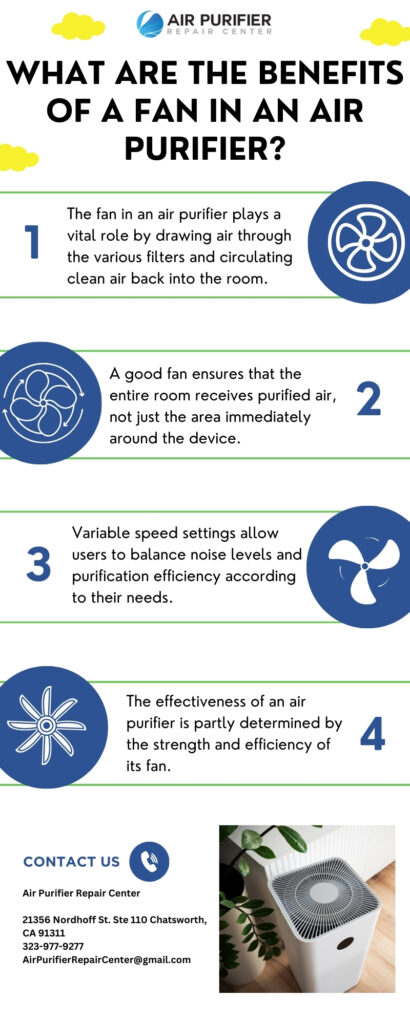Air purifiers have become essential appliances in homes, offices, and various spaces to maintain indoor air quality, especially as concerns about pollution and allergens grow. These devices consist of several components that work together to remove contaminants from the air, creating a cleaner and healthier environment. One of the critical components in an air purifier is the fan. While there are many essential air purifiers parts such as filters, sensors, and motors, the fan plays a pivotal role in ensuring the air is properly circulated, allowing other components to function optimally. This article explores the benefits of a fan in an air purifier and why it is integral to its performance.

1. Efficient Air Circulation
The primary purpose of the fan in an air purifier is to circulate air throughout the room. Without proper airflow, the purifier would be ineffective at drawing in polluted air, passing it through the filters, and releasing cleaner air back into the environment. The fan creates a continuous flow of air, ensuring that the purifier can clean all the air in the room rather than just the portion near the device.
For instance, in larger rooms or areas with more complex layouts, stagnant air may not easily reach the purifier if it doesn’t have a fan to pull the air from all corners of the room. The fan helps ensure that air from various parts of the room moves through the device, maximizing the purifier’s coverage.
2. Improved Filtration Efficiency
The fan’s role in facilitating airflow also directly impacts the efficiency of the filtration system. Air purifiers often rely on several types of filters, such as HEPA filters, activated carbon filters, or UV light filters, to remove contaminants like dust, pollen, pet dander, and harmful gases. For these filters to work effectively, air needs to pass through them continuously.
If an air purifier lacks a fan or has a weak one, the filtration process becomes sluggish. Contaminants in the air may linger longer in the environment before being filtered, which diminishes the overall efficiency of the device. With a powerful fan, air moves swiftly through the filters, ensuring that harmful particles are captured and removed from the air as quickly as possible.
3. Effective Coverage Area
The fan in an air purifier helps determine the size of the room the purifier can clean. Purifiers are often rated for certain square footage based on their airflow capabilities. A powerful fan can handle larger spaces because it can move more air through the filters within a given period. On the other hand, an air purifier with a weak fan may struggle to purify the air in larger rooms, resulting in inconsistent or incomplete air cleaning.
This is why the Clean Air Delivery Rate (CADR) is such a crucial metric in air purifiers. CADR measures how quickly a purifier can remove specific particles from the air, and it is directly influenced by the fan’s power. A higher CADR often indicates a more robust fan, allowing the purifier to tackle larger rooms and higher volumes of air. Without an effective fan, even the best filters may not achieve their full potential.
4. Reduced Allergens and Pollutants
For people suffering from allergies, asthma, or respiratory problems, reducing allergens and pollutants is a primary reason for using an air purifier. The fan’s role in this process cannot be overstated. By continuously moving air through the filters, the fan helps ensure that the air is constantly being cleaned, removing allergens like dust mites, mold spores, and pollen from the room.
In areas with high levels of pollution or in homes with pets, an air purifier’s fan ensures that particulate matter such as smoke, pet hair, and dander is efficiently removed from the environment. Without the fan, these particles would remain in the air for longer, exacerbating health problems or discomfort for individuals with sensitivities.
5. Even Air Distribution
Air purifiers without fans or with low-quality fans might only clean the air immediately surrounding the device. However, the fan in a high-performance air purifier ensures that air is evenly distributed throughout the space. This circulation ensures that all areas of the room benefit from cleaner air, not just those close to the purifier.
Even air distribution is particularly important in large rooms or open-concept spaces where airflow might be more restricted. The fan helps eliminate hotspots where pollutants might otherwise gather or linger, creating a consistently clean environment. This is especially beneficial in homes or offices with open windows, pets, or high foot traffic.
6. Noise Considerations
One of the trade-offs of having a fan in an air purifier is the noise it can generate. However, many modern air purifiers are equipped with fans designed to operate quietly. The noise level depends on the speed settings of the fan, with higher speeds often generating more sound. Fortunately, many purifiers offer adjustable fan speeds, allowing users to choose quieter settings during the night or when they require silence.
While some may see noise as a disadvantage, the benefits of improved air circulation and purification often outweigh this drawback. Moreover, the fan’s noise level can vary from model to model, and many advanced purifiers use noise-dampening technologies to minimize disturbance.
7. Enhanced Longevity of Filters
Another indirect benefit of the fan is the prolonged life of air purifier filters. With a fan circulating air efficiently, filters don’t become overloaded with contaminants as quickly. This allows the filters to operate longer before they need to be replaced, reducing maintenance costs and making the purifier more cost-effective over time.
When air moves steadily through the purifier, pollutants are less likely to accumulate unevenly in certain parts of the filter. This even distribution of particles across the filter surface helps avoid premature clogging and ensures that the filter’s entire area is used effectively. Regular airflow provided by the fan contributes to optimal filter performance and longevity.
8. Faster Air Purification
A high-powered fan allows an air purifier to clean the air more quickly. This is particularly important in spaces with high levels of pollutants or allergens, such as during allergy season, in homes with smokers, or in areas experiencing wildfires or other outdoor pollution events. The faster the fan can circulate the air through the filters, the sooner the air becomes clean.
For example, if a room is filled with smoke or cooking odors, a purifier with a strong fan can clear the air much faster than a purifier without one. This rapid air turnover is not only beneficial for comfort but also for health, as it reduces the time individuals are exposed to harmful contaminants.
9. Adjustable Fan Settings for Customization
Many air purifiers come with adjustable fan speed settings, allowing users to tailor the purifier’s operation to their needs. Lower speeds might be used during times of minimal activity, such as overnight when quiet operation is a priority, while higher speeds might be used during the day when pollutant levels are higher.
This level of customization ensures that the air purifier can meet the demands of various environments without using excessive energy or creating unnecessary noise. For example, in a home where people spend time in different rooms, higher fan speeds can be used in more populated areas while lower speeds are used in empty or lightly occupied rooms.
The fan is one of the most crucial air purifier parts, playing a vital role in maintaining proper airflow, improving filtration efficiency, and ensuring that air is evenly distributed throughout the room. Whether you are using an air purifier to combat allergens, pollutants, or just to maintain a healthier indoor environment, the fan ensures that the air you breathe is clean and fresh.


